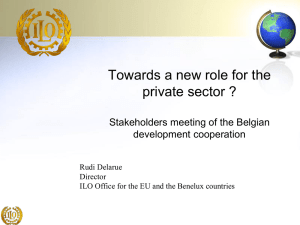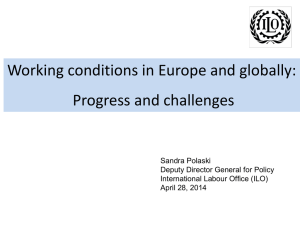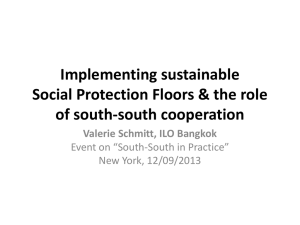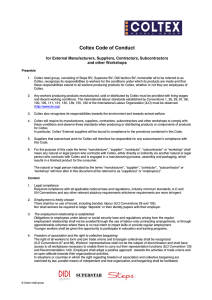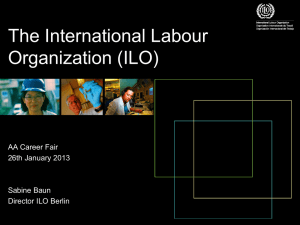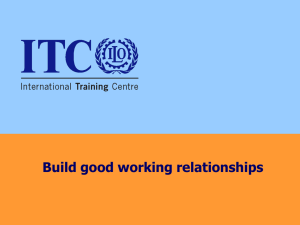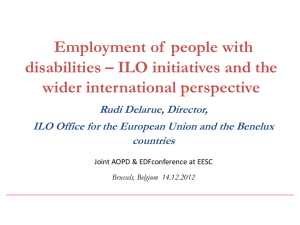- Gabrielekoehler.net
advertisement
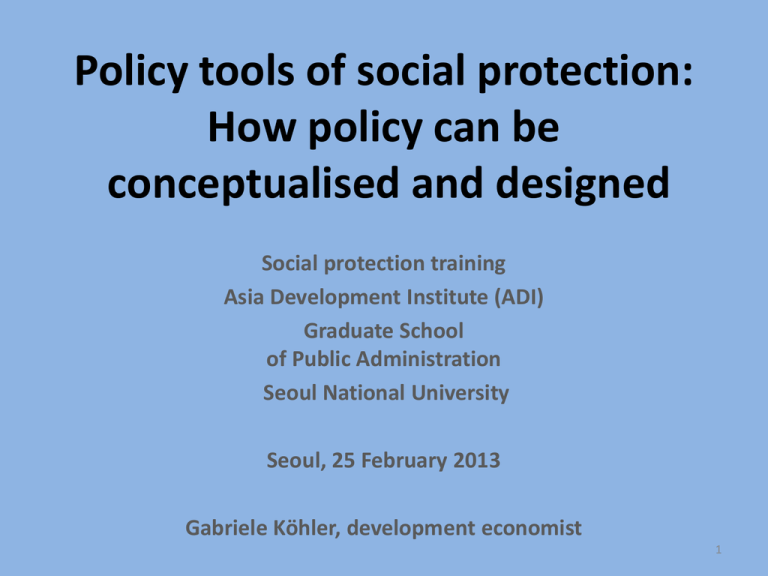
Policy tools of social protection: How policy can be conceptualised and designed Social protection training Asia Development Institute (ADI) Graduate School of Public Administration Seoul National University Seoul, 25 February 2013 Gabriele Köhler, development economist 1 Narrative Part I: Introduction 1. Definitions: social protection- social security – social assistance 2. The case for social protection 3. Trends globally and regionally 4. Principles, universal and regional Part II: Challenge: to build a system 1. Policies and strategies, design, management, administration 2. Financing and costing 3. “Policy construction” 4. Social protection systems: a selective overview 5. The ideal system 2 Part I: Introduction 3 Social security versus social assistance • Most countries of the world have social insurance schemes • BUT, in most low-income countries, only a small fraction of the population is covered by social insurance. 4 Social Protection Social Insurance Social Assistance Social Security Scheme Support in form of transfers (Non-Contributory Schemes/Programmes) (Contributory Schemes) 5 Social Protection Social Insurance Social Assistance Social Security Scheme Support in form of transfers (Contributory Schemes) Old age, sickness and accident, unemployment, maternity, invalidity, old age (Non-Contributory Schemes/Programme s) (ILO Convention 102) 6 The case for social assistance • majority of the world’s population: livelihoods from agriculture or fisheries, the informal economy, home-based work, (invisible) services • Enormous economic and social insecurities: vulnerability and risk, food insecurity, chronic and acute income poverty, systematic social exclusion • Very low social protection coverage rates 7 Low coverage rates: Old age pension coverage 8 Low coverage rates: unemployment protection Old age pension coverage 9 Social Protection Social Insurance Social Assistance Social Security Scheme Support in form of transfers (Non-Contributory Schemes/Programmes) (Contributory Schemes) Support against poverty; food subsidies; social pensions; education grants, child grants; public works programmes, etc (ILO Recommendation 202) 10 Social assistance trends • roughly 50 countries today provide some form of non-contributory social assistance • covering an estimated 10% of the world population 11 Conditional Cash Transfers in Latin America Argentina Programa Familias Bolivia Beca Futuro Brazil Bolsa Familia, Bolsa Escola Chile Chile Solidario Colombia Familias en Accion Program Costa Rica Programa Superemonos Ecuador Bono de Desarrollo Humano El Salvador Red Solidaria Honduras Programa de Asignacion Familiar Mexico Oportunidades Nicaragua Red de Proteccion Social 12 Unconditional Cash Transfers in Sub-Saharan Africa 13 Variety of Cash Transfers in Asia and the Pacific Bangladesh Employment scheme Cambodia National Social Protection Strategy China Dibao (minimum income) India NREGA; social pensions Indonesia Jamkesmas, Jampersal, PKH, Rice for the poor, PNPM Korea (Republic of) Targeted social protection transfers for vulnerable people Lao PDR … Mongolia Universal child benefit 14 Variety of Cash Transfers in Asia and the Pacific Myanmar Currently being developed Nepal Education grants; employment scheme; social pension Pakistan Benazir Income Support Programme Sri Lanka Samurdhi programme Thailand Universal health coverage scheme, minimum pension scheme Vietnam Social assistance to poor households and poor children: Conditional cash transfer focusing on disadvantaged communities (under consideration) 15 Right to Social Protection Universal Declaration of Human Rights (1948): Article 22: • Everyone, as a member of society, has the right to social security. International Covenant on Economic, Social and Cultural Rights (1966)• : Article 9: • The States Parties to the present Covenant recognize the right of everyone to social security, including social insurance. 16 Right to Social Protection Convention on the Eradication of All Forms of Discrimination against Women (CEDAW) (1979): Articles 11(e), 13(a), 14(c) • The right to social security, particularly in cases of retirement, unemployment, sickness, invalidity and old age and other incapacity to work, as well as the right to paid leave; • The right to family benefits; • Taking into account the particular problems faced by rural women and the significant roles which rural women play in the economic survival of their families … (c) To benefit directly from social security programmes. The Convention on the Rights of the Child (CRC) (1989): Article 26: • For every child the right to benefit from social security, including social insurance, and necessary measures to achieve the full realization of this right in accordance with national law. Convention on the Rights of Persons with Disabilities (CRPD) (2006) Article 28(b) • To ensure access by persons with disabilities, in particular women and girls with disabilities and older persons with disabilities, to social protection programmes and poverty reduction programmes. 17 Right to Social Protection ILO Convention C102: Social Security (Minimum Standards) Convention, 1952 • Outlines rights to benefits for residents of a country: accident, illness, unemployment, maternity, old age ILO Recommendation R202: Social Protection Floor 2012 • Four income “guarantees”: children, poor, elderly, health 18 ILO’s two-dimensional strategy for the extension of social security: Building comprehensive social security systems high Vertical dimension: progressively ensuring higher levels of protection, guided by Convention No.102 and more advanced standards extension strategy level of protection Voluntary insurance under government regulation Social security benefits of guaranteed levels floor level Social Protection Floor: Access to essential health care and basic income security for all low low individual/household income high Outcomes can be Social Protection Floor guaranteed through Recommendation, different means –adopted at ILC there is 2012 no one-size-fits-all Horizontal dimension: Guaranteeing access to essential health care and minimum income security for all, guided by Recommendation No. 202 19 Vietnam example: developing a social protection floor ASEAN 2009 Socio-cultural community blueprint • • • • • • Human development Social welfare and protection Social justice and rights Environmental sustainability An ASEAN identity Narrowing the development gap 21 Principles 7th ASEAN GO-NGO FORUM FOR SOCIAL WELFARE AND DEVELOPMENT • Everyone, especially those who are vulnerable, entitled to have equal access to social protection covering essential services; • Access to social protection – a human right that should be promoted, protected and fulfilled; • Universality of protection based on social solidarity, nondiscrimination, accessibility, gender equality, social inclusiveness, coherence, accountability, collective financing and risk pooling; • Implementation of SPF is part of national strategies for the progressive extension of social security towards higher level of protection; • Investment in people to empower them to meet their basic needs and adjust to changes in the economy and labour markets; • Cross-cutting issue, hence requires coordinated and holistic approaches; • Family unit is an important element in providing support to the vulnerable people and should be strengthened and preserved; • Governments, communities, civil society, private sector and social partners are key stakeholders; • Inclusive, participatory and rights-based approach in planning,22 programming and budgeting, implementation, M&E. BRICS and the „export“ of social protection Source: http://www.google.com/imgres?q= BRICS+map&hl=en&client=safari&sa=X&rls=en&biw=1280&bih=611&tbm=isch&prmd=imvns&tbnid=RqNceHxgRU8i9M:&imgrefurl= 23 ESCAP and social protection 24 Part II: Challenges • Sometimes large, but generally fragmented social assistance programmes, separated from social insurance Need to build a system of social protection 25 Indonesia: family-based social assistance programmes BLT Raskin Jamkesmas BSM PKH Program Unconditional Conditional Rice for the Health Scholarship Cash Transfer Cash Name Poor Protection for the Poor (2008-09) Transfer Type Cash Transfer Health Subsidized service fees Rice waived Target Poor & near Poor & near Poor & near group poor HHs poor HHs poor HHs (HHs) Number of 17.5 Mn 18.2 Mn HHs beneficiari 18.7 Mn HHs HHs es Benefit level IDR 100,000 15 kg rice per month per month Key Ministry of executing Social Affairs (MoSA) agency Unlimited Bureau of Ministry of Logistics Health (MoH) (BULOG) Cash Cash & Conditions Students from poor HHs Very poor HHs 8 Mn Students 1.5 Mn HHs IDR IDR 480,000 1,287,000 per year per year MoNE & MoRA MoSA 26 System building strategies •“top-down”: fostering processes of formalising the economy, so that all citizens move from the informal to the formal economy and become eligible for social insurance •“bottom-up”: universalising social assistance to cover all citizens – or even all residents 27 System building strategy o Defining the objectives o Conceptualising the policy model o Design: Laying out eligibilities o Management: coordination; recording participants 28 Philippines: objectives of the conditional cash transfer o To raise the average o o o o consumption rate in food expenditure of poor households To increase the enrollment in and attendance rate of children in school To improve preventive health care among pregnant women and young children To reduce the incidence of child labor To encourage parents to invest in their children’s (and their own) human capital through investments in their health and nutrition, education, and participation in community activities Selection Procedures of Target Households Geographical Targeting Household Assessment (Enumeration) Selection of Poor Beneficiaries using Proxy Means Test Eligibility Check 29 System building: design components • Universal for some types of social assistance (pensions, child grants) • Targeted for other types – by income levels, identity groups, disadvantaged regions • Conditional on behaviours • Unconditional 30 Indonesia: national targeting system The National Targeting System identifies and chooses beneficiaries (households, individuals, etc.) of targeted poverty reduction or social protection programs. Poor Past system: each program has its own list of targeting system Now gradually moves into unified targeting system Minimizing inclusion & exclusion errors Not-Poor Beneficiary of Programs Non-beneficiary of Programs 31 System building: management • define roles and responsibilities of respective governmental ministries and departments that often each administer separate social assistance schemes • create an overarching coordinative body (Cambodia, Myanmar) • M&E • Claims and grievance mechanisms • Information access 32 System building: administration • citizens´ registries (India; Indonesia) • “single window” access to social assistance (Cambodia) • bank transfer modalities (Pakistan) 33 System building: financing • actuarial calculations of population trends • trends for beneficiary entitlements over time estimating the required budget, revenue collection negotiating fiscal space to reliably fund social protection over the long term 34 Fiscal diamond 35 36 Annual costs of social protection programmes – middle income countries 37 Social protection expenditures in % of GDP, 75 low-income countries 38 39 40 Thailand: Social floor costing example 400,000 1.6% GDP 350,000 300,000 0.9% GDP Pension 250,000 Disability allowance 200,000 Training skill 150,000 Sickness benefit 100,000 Maternity allowance 50,000 0 2012 2013 2014 2015 2016 2017 2018 2019 2020 Universal Child allowance 41 System building: social protection policy construction • to define the policy – its overarching principles and objectives • to build coalitions or a social compact between tax-paying middle and high income groups and those who stand to gain initially from an enhanced and unified social assistance system • to create and adopt the necessary legislation • to recognise and seize the policy moment 42 Social protection policy construction “Middle classes” Elites in legislation or decision making Grass roots organisations, trade unions and their connections to the “poor” International pressure or models or fashions 43 Systems approaches Country Name Brazil Cambodia China Indonesia Mexico South Africa Vietnam Sistema Unico de Assistencia Social (SUAS) Features & functions Covers social assistance. Federation of various levels and programmes Coordination with finance. Participatory model via periodic conferences and representatives National Social Protection Covers social assistance, health insurance, employment schemes System 5 ministries (social affairs, health, education, labour and vocational training, rural development). •Coordinates policies •Supervises social protection and pubic employment schemes, as well as health insurance, education grants etc •Monitors NSPS (based on DB) Complex system 2 minimum living standard guarantee schemes (urban and rural residents below the locally-defined income threshold); 3 health insurance programmes (urban working population; rural; economically inactive populations). New rural pension system. Complex system, with PT Jamsostek: employment-related insurance for informal sector workers; Medium Term National Plan Program Nasional Pemberdayaan Masyarakat (PNPM) A community empowerment (2010-2014) as overarching programme in poor districts and sub-districts; Bantuan Operasional Sekolah commitment (BOS) Programme: block grants to schools Vivir Mejor Coordinates Oportunidades, conditional cash transfer for poor families; 70 y Más social pension scheme for the elderly; and the Seguro Popular health insurance scheme for previously uninsured families South African Social Security 3-pillar approach to social security: non-contributory (tax-financed), contributory Agency and private voluntary pillars. 1st pillar: Old age grant (to citizens aged 60 and older); Disability grant; Care dependency grant; Child support grant (payable to poor households with children) etc. Free Primary Healthcare to pregnant mothers, people with disabilities, pensioners and the indigent. 2nd pillar includes Unemployment Insurance Fund – protecting retrenched workers, including those in the informal economy. party resolution on key labour market policies, social insurance policies, health-care policies, social social policies 2012-2020. welfare/assistance, poverty reduction programmes and access to public social (mainly social protection, services. Universal health-care coverage by 2014; to provide access to basic replaces draft National Social social services for all such as education, health care, housing, drinking water, 44 Protection Strategy) electricity, information, sanitation and legal advice; and to provide a minimum income to those in need Pathways to social protection systems India: RSBY, NREGA Cambodia: NSPS with clear reference to the SPF … including HEFs, CBHIs, Food distribution, PWPs,… Thailand: UC scheme, minimum pension scheme (500 THB) Indonesia: Jamkesmas, Jampersal, PKH, Rice for the poor, PNPM China: minimum living standard guarantee program; new rural corporative medical care (NRCMC); health insurance for urban uninsured residents (HIUR); rural old-age pension Laos: extension of SHP for all Philippines: universal health reform Nepal: broad range of transfers Vietnam: 10 years Social security strategy 45 THE IDEAL SOCIAL PROTECTION SYSTEM Rights based - Universal right/universal coverage Citizenship- or residents-based Coherence with other policy areas Accompanied by supply side measures (social services, health and education) Accompanied by decent work policy & action Addresses crises, chronic poverty, vulnerabilities, inequalities, social exclusion Well-targeted and publicised entitlements and special efforts to reach disadvantaged households/communities Sustainable, predictable, meaningful benefit levels Affordable and long-term sustainability Tax financed, linking social protection reform and tax reform Empowerment: guaranteeing space for civil society and public action Built on notion of social solidarity Advanced IT Monitoring & evaluation systems Transparency and right to information Accountability and complaint and appeals mechanisms Systemic – uniting fragmented programmes systems Legally binding 46 Resources ASEAN 2012. RECOMMENDATIONS. THE SEVENTH ASEAN GO-NGO FORUM FOR SOCIAL WELFARE AND DEVELOPMENT “Promoting Social Services and Social Protection for Vulnerable Groups” . 12 September 2012, Ha Noi, Viet Nam. www.socialsecurityextension.org/gimi/gess/RessFileDownload.do Bachelet Michelle 2011. Social protection floor for a fair and inclusive globalization. Report of the Advisory Group. ILO 2011. http://www.ilo.org/global/about-‐the-‐ ilo/press-‐and-‐media-‐centre/news/WCMS_166292/lang-‐‐en/index.htm Barrientos, Armando , Miguel Niño-Zarazúand Mathilde Maitrot Brooks 2010. Social Assistance in Developing Countries Database. Version 5.0 July 2010. World Poverty Institute. The University of Manchester. http://papers.ssrn.com/sol3/papers.cfm?abstract_id=1672090 Centre for Social Protection 2013. Talking Point on Systems of Social Protection, CSP Newsletter 23, February 2013, IDS. By Gabriele Köhler. http://www.ids.ac.uk/files/dmfile/CSPNewsletter23formattedFinal2.pdf. ESCAP, 2011. The promise of protection. Social Protection and development in Asia and the Pacific. Bangkok European Commission 2012. Social Protection in European Union Development Cooperation . COMMUNICATION FROM THE COMMISSION TO THE EUROPEAN PARLIAMENT, THE COUNCIL, THE EUROPEAN ECONOMIC AND SOCIAL COMMITTEE AND THE COMMITTEE OF THE REGIONS Brussels, 20.8.2012 COM(2012) 446 final http://ec.europa.eu/europeaid/what/social-protection/documents/com_2012_446_en.pdf Hickey, Sam 2008. Conceptualising the politics of social protection in Africa. In A. Barrientos & D. Hulme (Eds.), Social Protection for the Poor and Poorest: Concepts, Policies and Politics. London: Palgrave. Holmes, R. (2008). Child Poverty: a role for cash transfers? 47 Resources cont´d ILO 2010. Social Security for All. www.ilo.org ILO 2010. Extending social security to all. A guide through challenges and options . http://www.ilo.org/wcmsp5/groups/public/---dgreports/---dcomm/--publ/documents/publication/wcms_146616.pdf ILO 2012. Social Protection Floors Recommendation, 2012 (No. 202) http://www.socialprotection.org/gimi/gess/RessShowRessource.do?ressourceId=31088 ILO 2012. Social protection floors for social justice and a fair globalization. Report IV (1) . Geneva ILC.101/IV/http://www.ilo.org/public/english/protection/secsoc/downloads/policy/rapiven.pdf ILO Regional Office for Asia and the Pacific. 2012. Single Window Service in Asia and the Pacific. Piloting integrated approaches to implementing Social Protection Floors. http://www.socialprotection.org/gimi/gess/RessShowRessource.do?ressourceId=30172 ISSA. International Social Security Association. http://www.issa.int/Observatory/Country-Profiles UNICEF Myanmar 2012. Social protection: A Call to Action. Conference report. Yangon 2012 World Bank 2012. Resilience, Opportunity and Equity. The World Bank’s Social Protection and Labor Strategy 2012–2022. www.worldbank.org 48 ANNEX • List of costing tools • ILO´s social protection assessment tool 49 Costing tools • Basic social protection tool - Electronic model (ILO & UNICEF) • Simulation and costing tool ADePT (World Bank) • Micro-simulations (ILO) • Actuarial and financial advisory services (ILO FACTS) • Performance Indicators (PIS) of Statutory Social Insurance Schemes (ILO) • Pension costing tool (HelpAge) • Pension reform options simulation toolkit (PROST) (World Bank) • Modeling for health insurance (WHO) • Modeling for agricultural/crop insurance systems (UNCTAD/World Bank) • Rapid Assessment Protocol (RAP) (ILO) • Rapid Assessment Protocol Plus (RAP+) (ILO) • Marginal Budgeting for Bottlenecks (UNICEF/World Bank) 50 Analysing social protection options Step 1 –Assessment of social protection situation SPF objectives Existing SP Planned SP provision provisions (strategy) Gaps Design gaps Implementation issues Recommen dations Health Children Working age Elderly The Social Protection Situation Social Protection Floor template: guarantees and objectives Design gaps and implementation issues (to complete the SPF) Priority policy options to be decided through national dialogue 51 Analysing social protection options Step 2 – Costing of “SPF” recommendations •Decide on priorities in social protection •Design appropriate interventions •Estimate the cost of each intervention, with alternative level of coverage and benefits, with a good time line •Various costing tools available from UN agencies •Choose appropriate, affordable, sustainable interventions •Combine with a fiscal budget analysis 52
